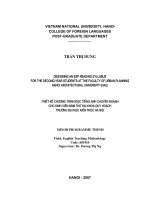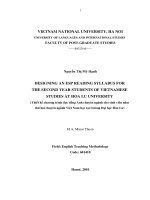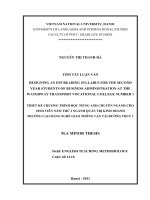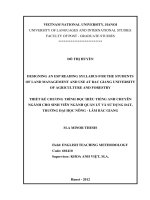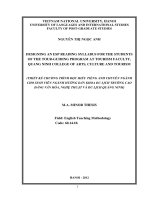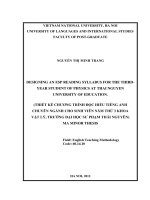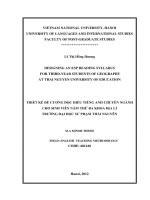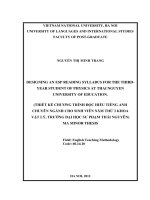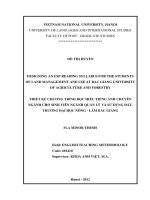Designing an ESP reading syllabus for the students of the Tour-guiding program at Tourism Faculty, Quang Ninh College of Arts, Culture and Tourism Thiết kế chươ
Bạn đang xem bản rút gọn của tài liệu. Xem và tải ngay bản đầy đủ của tài liệu tại đây (1.17 MB, 62 trang )
1
Vietnam national university, Hanoi
UNIVERSITY OF LANGUAGES AND INTERNATIONAL STUDIES
FACULTY OF POST-GRADUATE STUDIES
NGUYỄN THỊ NGỌC ANH
DESIGNING AN ESP READING SYLLABUS FOR THE STUDENTS
OF THE TOUR-GUIDING PROGRAM AT TOURISM FACULTY,
QUANG NINH COLLEGE OF ARTS, CULTURE AND TOURISM
(THIẾT KẾ CHƯƠNG TRÌNH ĐỌC HIỂU TIẾNG ANH CHUYÊN NGÀNH
CHO SINH VIÊN NGÀNH HƯỚNG DẪN KHOA DU LỊCH TRƯỜNG CAO
ĐẲNG VĂN HÓA, NGHỆ THUẬT VÀ DU LỊCH QUẢNG NINH)
M.A. MINOR THESIS
Field: English Teaching Methodology
Code: 60.14.10.
HANOI - 2012
2
Vietnam national university, Hanoi
UNIVERSITY OF LANGUAGES AND INTERNATIONAL STUDIES
FACULTY of post - graduate studies
NGUYỄN THỊ NGỌC ANH
DESIGNING AN ESP READING SYLLABUS FOR THE STUDENTS
OF THE TOUR-GUIDING PROGRAM AT TOURISM FACULTY,
QUANG NINH COLLEGE OF ARTS, CULTURE AND TOURISM
(THIẾT KẾ CHƯƠNG TRÌNH ĐỌC HIỂU TIẾNG ANH CHUYÊN NGÀNH
CHO SINH VIÊN NGÀNH HƯỚNG DẪN KHOA DU LỊCH TRƯỜNG CAO
ĐẲNG VĂN HÓA, NGHỆ THUẬT VÀ DU LỊCH QUẢNG NINH)
M.A. MINOR THESIS
Field: English Teaching Methodology
Code: 60.14.10.
Supervisor: Dr. DƯƠNG THỊ NỤ
HANOI - 2012
iv
TABLE OF CONTENTS
DECLARATION……………………………………………………………
ACKNOWLEDGEMENTS……………………………………………………
ABSTRACT………………………………………………………………………
TABLE OF CONTENTS………………………………………………………
LIST OF TABLE AND FIGURES……………………………………………
PART I: INTRODUCTION…………………………………………………
1. Rationale of the research………………………………………………………
2. Aims of the research …………………………………………………………
3. Research questions…………………………………………………………….
4. Methods of the research……………………………………………………….
5. Scope of the research …………………………………………………………
6. Design of the research…………………………………………
PART II: DEVELOPMENT …………………………………………………
CHAPTER 1: LITERARTURE REVIEW
1.1 An overview of ESP…………………………………………
1.1.1 Definition of ESP……………………………………………
1.1.2 Types of ESP………………………………………………
1.2 An overview of syllabus design……………………………
1.2.1 Definition of syllabus……………………………………… .
1.2.2 Types of syllabus…………………………………………….
1.2.2.1 Content-based syllabus………………………………….
1.2.2.1.1 Structural syllabus………………………………………
1.2.2.1.2 Situational syllabus………………………………………
1.2.2.1.3 Notional/Functional syllabus……………………………
1.2.2.1.4 Topic syllabus
1.2.2.2 Skill-based syllabus………………………………………
i
ii
iii
iv
vii
1
1
2
2
2
2
3
4
4
4
4
6
6
7
8
8
8
9
9
9
10
10
v
1.2.2.3 Method-based syllabus…………………………………
1.2.3 Approaches to ESP syllabus design…………………………
1.2.4 Steps to design a syllabus…………………………………….
1.2.5 Needs analysis………………………………………………
1.3 Theories of reading……………………………………………
1.3.1 Reading in ESP……………………………………………
1.3.2 Reading skills and strategies in ESP……………………….
1.4 Summary………………………………………………………
CHAPTER 2: THE STUDY
2.1 The teaching and learning ESP situation at Quang Ninh College of Art,
Culture and Tourism……………………………………………
2.2 The teaching staff of the English Division…………………
2.3 The students………………………………………………….
2.4 The study…………………………………………………
2.4.1 The subjects…………………………………………………
2.4.2 Instruments for collecting data……………………………
2.4.3 Procedures…………………………………………………
2.4.4 The findings………………………………………………
2.4.4.1 Needs perceived by the teachers of English Faculty
2.4.4.2 Needs perceived by the teachers of Tourism Faculty
2.4.4.3 Needs perceived by the Tour-guiding students
2.5 Summary………………………………………………………
CHATER 3: DESIGNING AN ESP READING SYLLABUS FOR THE
STUDENTS OF THE TOUR-GUIDING
3.1 Aims and objectives of reading syllabus…………………………………
3.2 Selecting types of ESP syllabus…………………………………………
3.3 Sequencing the content and the tasks in the syllabus
3.4 Designing tests for the ESP reading course
3.5 The proposed syllabus for the students of the Tour-guiding at Tourism
10
11
12
14
15
15
17
17
18
18
19
19
19
19
20
21
26
26
26
27
28
29
vi
Faculty, Quang Ninh College of Art, Culture and Tourism
3.6 Summary
PART III: CONCLUSIONS……………………………………………
1. Recapitulation
2. Conclusions
3. Limitations of the study
4. Suggestions for further study
REFERENCES.
APPENDICES ………………………………………………………
31-40
29
30
30
31
31
I-XXI
vii
LIST OF TABLES AND FIGURES
Figure 1: ESP classification by experience 7
Figure 2: ESP classification by Professional area 8
Figure 3: A language-centered approach 13
Figure 4: A skill-centered approach 14
Figure 5: A learning-centered approach 15
Table 1: Teachers’ expectations of the ESP reading course XI
Table 2: Teachers’ ranking of topics related to Vietnam and Quang Ninh tourist
attractions XII
Table 3: Teacher’s ranking of grammar and structures needed for the syllabus XIII
Table 4: The teachers’ attitudes to reading skill and exercises needed for reading
comprehension in the syllabus XIV
Table 5: The students’ rating of the objectives of the syllabus XVI
Table 6: Students’ assessment of the topics about Vietnam and Quang Ninh tourist
attractions XVII
Table 7: Students’ opinion of the reading skills and exercises needed in the syllabus
XVII
1
PART I: INTRODUCTION
1. Rationale
English for Specific Purposes (ESP) plays an important role in a global community of
people speaking different languages. People with good English proficiency are extensively
needed in many areas, such as business, banking, telecommunications, tourism, etc. With
the globalization of trade and economy and the continuing increase of international
communication in various fields, the demand for ESP is expanding, especially in countries
where English is taught as a foreign language. In Vietnam, ESP has really become a
necessary and indispensable branch in English language teaching. The students who want
to get the best preparation for their future career are paying more and more attention to the
learning of ESP. Therefore, ESP is introduced in many colleges and universities as a
compulsory subject in curriculum.
Students learning ESP in Vietnam mainly get access to popular documents written in
English through reading. Hence, skills in reading texts are obviously of special significance
in teaching and learning ESP.
At Quang Ninh College of Arts, Culture and Tourism, different ESP courses are taught to
students of different majors. After completing a 90-period General English, students of the
tour-guiding program at Tourism faculty will progress to the ESP stage. Teachers of
English Division who are asked to teach ESP have a lot of difficulties because of the lack
of an appropriate ESP teaching syllabus. The materials for the course are not available so
that the teachers have to spend much time searching, considering and choosing the most
suitable ones to for their students. I realized that designing a proper syllabus is of great
necessity. This is the main reason why “ Designing an ESP reading syllabus for the
students of the Tour-guiding program at Tourism Faculty, Quang Ninh College of Arts,
Culture and Tourism” is chosen for my thesis.
2. Aims and objectives of the study
This study aims at designing an ESP reading syllabus for the students of the Tour-guiding
program at Tourism Faculty, Quang Ninh College of Arts, Culture and Tourism. To
achieve this aim, the following objectives are established:
2
- To develop a theoretical framework related to a reading syllabus for
English for Tourism in Vietnam
- To identify the needs of the ESP teachers, the ESP students of the Tour-
guiding program at Tourism Faculty, Quang Ninh College of Arts Culture
and Tourism
- To propose a reading syllabus based on the relevant theories and the needs
analysis.
3. Research questions
The study answers two questions:
1. What are the target needs from the perspective of the ESP students and the ESP
teachers?
2. What is the content of the syllabus?
4. Methods of the study
This survey research is both qualitative and quantitative. The first method by means of
questionnaires aims at identifying the needs for the ESP syllabus from the ESP students of
the Tour-guiding program. The second one is used to collect various ideas through
interviews.
5. Scope of the study
This study is limited to design an appropriate ESP reading syllabus about the famous
destinations in Quang Ninh and Vietnam for the second-year students of the Tour-guiding
program at Quang Ninh College of Arts, Culture and Tourism.
6. Design of the study
The study contains three main parts:
Part I: Introduction present the rationale, aims, research questions, methods, scopes, and
the design of the study.
Part II: Development consists of three chapters:
- Chapter 1 reviews the literature related to ESP, ESP syllabus design and reading
theories.
3
- Chapter 2 describes the study including its background, subjects, and instruments for
collecting and analyzing data for the findings of the study.
- Chapter 3 proposes a reading syllabus based on the findings of this study.
Part III: Conclusion provides recapitulation, conclusions, limitations of the study and
suggestions for further research.
4
PART II: DEVELOPMENT
CHAPTER 1: LITERARTURE REVIEW
There are many previous studies about tourism. Some of them were carried out to develop
the materials for the English for tourism. Some others were designed to improve students’
speaking skill that is very necessary for tour guides. However, no research so far has been
implemented to design a reading syllabus for the students of Tour-guiding program which
is expect to contain information on most popular sites of Vietnam and Quang Ninh.
Therefore, it is an urgent need to do a research to put these ideas about this reading
syllabus with suitable task into practice.
In this chapter, an attempt is made to review the theories related to all basic aspects for
designing and ESP reading syllabus, including theories of ESP (definitions and types),
theories of syllabus (definitions, types and approaches to ESP syllabus design) and theories
of reading (reading skills and strategies).
1.5 An overview of ESP
1.5.1 Definition of ESP
It is not easy for most teachers and students of English to give an exact definition of ESP.
Even great scholars of language define ESP from various approaches.
Hutchinson and Waters (1987) defined ESP as follows:
English for specific purposes (ESP) is one important branch of the EFL/ ESL (English as a
Foreign Language/ Second Language) system that function as the main branch of English
Language Teaching (ELT). Therefore, ESP is not a particular kind of language or
methodology, but rather an approach to language learning whereby the content and method
are based on the learners’ particular needs to learn the language.
Richards, Platt and Webber (1994) affirm that ESP course “is fixed by the specific needs
for a particular group of learners”. Likewise, Widdowson (1983) argued that the distinction
between ESP and EGP (English for General Purpose) is not the problem of specificity of
purpose but “the way in which purpose is defined and the manner of its implementation”.
Strevens (1988) works out a more detailed definition of ESP, which make a distinction
between four absolute characteristics and two variable characteristics. The absolute
characteristics are that ESP consists of ELT which is:
5
designed to meet the specified needs of the learner;
related in content (that is in its themes and topics) to particular disciplines,
occupations and activities;
centered on language appropriate to those activities in syntax, lexis, discourse,
semantics and so on, and analysis of the discourse;
in contrast with “General English”
Robinson (1991) also accepts the primacy of needs analysis in defining ESP. Her definition
is based on two key defining criteria (ESP is “normally goal-directed”, and ESP courses
develop from a needs analysis) and a number of characteristics (ESP courses are generally
constrained by a limited time period, in which their objectives have to be achieved, and
that are taught to adults in homogeneous classes in terms of work or specialist studies that
the student are involved in) generally found to be true of ESP.
Each definition has validity but also weaknesses. In 1998, Dudley-Evans and St John gave
out a modified definition which is very helpful in resolving the arguments about what is
and is not ESP. The definition is:
Absolute characteristics:
- ESP is design to meet the specific needs of the learner;
- ESP makes use of the underlying methodology and activities of the disciplines it
serves;
- ESP is centered on the language (grammar, lexis, and register), skills, discourse and
genres appropriate to these activities.
Variable characteristics:
- ESP may be related to or designed for specific disciplines;
- ESP may use, in specific teaching situation, a different methodology from that of
general English;
- ESP is likely to be designed for adult learners, either at a tertiary level institution or in
a professional work situation. It could, however, be used for learners at secondary
school level;
- ESP is generally designed for intermediate or advanced students. Most ESP courses
assume basic knowledge of the language system, but it can be used with beginners.
6
1.5.2 Types of ESP
ESP has traditionally divided into two main areas: English for Academic Purposes (EAP)
and English for Occupational Purposes (EOP). Robinson (1991) devises a tree diagram for
ESP (Figure 1), which divides EAP and EOP according to when they take place while
Dudley-Evans and St John (1998) divide EAP and EOP according to discipline or
professional area (Figure 2). On the other hand, in the “tree of ELT” of Hutchinson and
Waters (1987), ESP is broken down into three branches: English for Science and
Technology (EST), English for Business and Economics (EBE), and English for Social
Studies (ESS). Each of the subject’s areas is further divided into two branches: EAP and
EOP. However, they find out that there is not a clear-cut distinction between EAP and EOP
because “ people can work and study simultaneously; it is likely that in many cases the
language learnt for immediate use in a study environment will be used later when the
student takes up, or returns to a job”. Therefore, it is important for ESP teachers to study
various types of ESP to have an overall picture of the group of learners they are going to
work with.
Figure 1: ESP classification by experience
(Taken from Robinson, 1991:3-4)
ESP
EOP
EEP/EAP
Pre-experience
Simultaneous/ in service
Post-experience
For study in a
specific
discipline
As a school
subject
Pre-study
In-study
Post-study
Independent
Integrated
7
Figure 2: ESP classification by Professional area
By Dudley-Evans and St John (1998)
1.6 An overview of syllabus design
1.6.1 Definition of syllabus
A syllabus can be defined differently by various authors. According to Hutchinson and
Waters (1987:80) “at simplest level, a syllabus can be described as a statement of what to
be learnt. It reflects of language and linguistic performance.” A syllabus can also be seen
as a “summary of the content to which learners will be exposed” (Yalden, 1987:87). On
the other hand, Nunan (1988:5) defines syllabus by the distinction between content and
methodology “Syllabus design is seen as being concerned essentially with the selection and
grading of content while content and methodology is concerned with the selection of
learning task and activities.
Among different ways of defining a syllabus, in this study I apply the one that provides a
sufficiently broad base. It is the Candlin’s summary of a syllabus (1984:30)
“Syllabuses are concerned with the specification and planning of what is to be learned,
frequently set down in some written form as prescriptions for action by teachers and
learners. They have, traditionally, the mark of authority. They are concerned with the
achievement of ends, often, though not always, associated with the pursuance of particular
English for Specific Purposes
English for Academic Purposes
English for Occupational Purposes
English for
(Academic)
Science and
Technology
English for
(Academic)
Medical
Purposes
English for
(Academic)
Legal
Purposes
English for
Management,
Finance and
Economics
English for
professional Purposes
English for
Vocational Purposes
English
for
Medical
Purposes
English
for
Business
Purposes
Pre-
vocational
English
Vocational
English
8
means”. This definition recognizes most of the academic and social implications of
syllabuses without specifically prescribing the results and processes of syllabus design.
1.6.2 Types of syllabus
Syllabuses are divided into many kinds according to various researchers. They have
organized syllabuses basing on structure (Ellis, 1997), words (Willis, 1990), skills
(Johnson 1976) or notions and functions (Wilkins, 1976). Up to now, the most common
classification to ELT is of Robinson (1991:35). He suggests three major types of syllabus:
content-based syllabus, skill-based syllabus and method-based syllabus.
1.6.2.1 Content-based syllabus
1.6.2.1.1 Structural syllabus
Structural syllabus is considered the most prevalent type for the teaching of a language in
which the selection and grading of the content is from the simple to the complex. It focuses
on the product, so each structural step is expected to master and add to students’ grammar
collection. Although this kind of syllabus represents a familiar approach to teaching for
many people, it faces a problem that makes it infeasible. The matter is that the only focus
of the structural syllabus is grammar while there are many other aspects students need to
learn in language. Nunan (1988:30) also points out that “structural graded syllabus
misrepresented the complex nature of language as a system and tended to focus on only
one aspect of language, that is, formal grammar.”
1.6.2.1.2 Situational syllabus
This kind of syllabus is “always used in social context and cannot be understood without
reference to that context” (Wilkins, 1976:16). Hence, basing on situations in which
language is used the designer can choose and present language content. This feature makes
the situational syllabus be used practically in context. Another advantage is that it will
motivate the learners because it is “learner rather than subject centered” (Wilkins,
1976:16). However, language used in specific situations may not transfer to other
situations. This is one of the limitations of this kind of syllabus. Moreover, it is effective
only if the designer can predict accurately the situation in which the learners will find
themselves. Gaps in students’ grammatical knowledge may appear incidentally when using
a situational syllabus.
1.6.2.1.3 Notional/Functional syllabus
9
Wilkin (1976) suggests that this kind of syllabus has a main concern about the teaching of
meaning and the communicative use of patterns. That means it expresses what people
communicate through language and its content is selected from an analysis of the learner’s
need to show certain meaning. Therefore, the content of the notional/functional syllabus is
a list of the functions or notions that are performed when language is used. The
notional/functional syllabus takes the communicative facts of language into account
without losing sight of grammatical and situational factors, but the lack of clear criteria
causes a lot of issues in choosing and grading function and form.
1.6.2.1.4 Topic syllabus
This kind of syllabus is designed basing on content rather than grammar, functions or
situations. The syllabus designer selects the topics or themes on the basic of the perception
on their importance to the target students. According to Robinson (1991), topic syllabus
motivates the students and it is the starting point for the “real syllabus” of the language
forms, tasks or whatever the course designers wish to focus on. This kind of syllabus has
advantage of serving the multiple interests of students in a classroom and offering a focus
on content while still adhering to institutional needs for offering a language course (Brown,
1994: 222). Topic syllabus also shows drawbacks besides the above advantages. Finding
the balance, grading and defining the semantic construct are the main difficulties for
designers.
1.6.2.2 Skill-based syllabus
Skills are the key factors that learners must be competent when learning a language. Skill-
based syllabus is of great significance because this kind of syllabus helps learners develop
skills and strategies and provides a practical framework for designing course and teaching
materials. With this kind of syllabus, linguistic competencies can be grouped together into
generalized types of behavior, such as listening to spoken language for the main idea,
writing well-formed paragraphs, and so on. However, focusing on discrete aspects of
performance rather than on developing global and integrated communicative abilities is
regarded as the problem of skill-based syllabus.
1.6.2.3 Method-based syllabus
1.6.2.3.1 Task-based syllabus
Robinson (1991:39) points out that a task-based syllabus is “the syllabus consisting of a set
of tasks or activities ordered according to cognitive difficulty”. The aim of task-based
10
syllabus is to teach students how to draw on resources to complete some pieces of work.
By completing tasks, students are able to master a variety of language forms, functions and
skills. Robinson (1991:40) also states that “using the medium of English, they should
successfully perform a work or a study task.”
1.6.2.3.2 Process syllabus
The process syllabus is defined as “a context within which any syllabus of subject-matter is
made workable” (Breen, 1987:196). In the areas of language, teaching methodology,
learner contribution and planning for learning and teaching this kind of language shows
many differences. It the only syllabus that not pre-set but rather constructed as the course is
taught. The designer no longer pre-selects learning content, but provides framework for
teacher and learners to create their own on-going syllabus. Process syllabus is also seen as
innovative one for it is largely focused on project work and problem-solving tasks and
activities.
In short, each kind of syllabus type above contains strengths and weaknesses. Hutchison
and Waters (1987:51) states “it is wise to take an eclectic approach, taking what is useful
form each theory and trusting also in the evidence of your own experience as a teacher.
Thus, to what extent has an integration of the various approaches taken place? Does the
syllabus specification include all aspect? If yes, how is priority established? These
questions must also form part of the criteria when designing or accessing your own
syllabus.” Therefore, when designing a syllabus the designer must have the right choices.
1.6.3 Approaches to ESP syllabus design
There are three main types: language-centered approach, skilled-centered approach and
learning -centered approach.
1.6.3.1 Language-centered approach
This simple process is not only familiar to English teachers but also popular in ESP. Its
main focus is the connection between the analysis of the target situation and the content of
ESP course. This is a logical and direct process but there are some weaknesses. Firstly,
although its starting point is learners’ needs, only a restricted area of the language is
taught, which doesn’t meet the students’ demands. Secondly, it is said to be static and
inflexible. Thirdly, other learning factors are not paid enough attention because of the
completely dependence on the target situation. Finally, the finding of the analysis of target
11
situation is only at the surface level which hides more competence that underlines the
performance.
Figure 3: A language-centered approach
1.6.3.2 Skilled-centered approach
This approach provides a basis for discovering the underlying competence that enables
people to perform in the target situation. It also enables the course designer to discover the
potential knowledge and helps learners to develop skills and strategies. The objective of
this process is to make learners into better processors of information. However, according
to Hutchinson and Water (1987) the drawback of this approach is that it still sees the
learners as a user of language rather than as a learner of language with its process of
language use, not of language learning.
Identify learners’ target
situation
Identify linguistic features of target situation
Create syllabus
Select theoretical views of
language
Establish evaluation procedures to test acquisition of
syllabus items
Design materials to
exemplify syllabus items
12
Figure 4: A skill-centered approach
1.6.3.3 Learning-centered approach
Learning-centered approach places the student at the center. That means learning is wholly
decided by learners. It begins with understanding the educational contexts from which a
student comes. It continues with the instructor evaluating the student's progress towards
learning objectives. By helping the student acquire the basic skills to learn, it ultimately
provides a basis for learning throughout life. It therefore places the responsibility for
learning on the student, while the instructor assumes responsibility for facilitating the
student’s education. This approach strives to be individualistic, flexible, competency-
based, varied in methodology and not always constrained by time or place.
Theoretical view
of language
Analyze skills/strategies
required to cope in target
situation
Identify
target
situation
Theoretical
view of
language
Write
syllabus
Select texts
and write
exercises to
focus on skills
or strategies
in syllabus
Establishing
evaluation
procedures
which require
the use of
skills/strategies
in syllabus
13
Figure 5: A learning-centered approach
To sum up, each approach reveals its own advantages and disadvantages. The language -
centered model makes the ESP course too independent on the target situation. The second
approach, skill-centered approach, views learner as a user rather than a learner of language.
The last approach pays attention to competence and performance. After a careful
consideration of different approaches, an integrated approach with much focus on the
combination of the target situation, competence and performance factors will be adopted to
an ESP reading syllabus for students of Tour-guiding program. With an integrated
syllabus, I hope to increase the strengths and minimize the drawback of the given ones.
1.6.4 Needs analysis
Needs analysis plays a vital role in the process of designing and carrying out any language
course, whether it be English for Specific Purposes (ESP) or general English course. There
are many different definitions of need analysis. According to Iwai (1999), the term needs
analysis generally refers to the activities that are involved in collecting information that
will serve as the basis for developing a curriculum that will meet the needs of a particular
group of students. Besides, need analysis is seen as “the process of determining the needs
Identify learners
Theoretical
views of
learning
Analyze
learning
situation
Analyze
Target
situation
Theoretical
views of
language
Identify
attitudes/wants/potential of
learners
Identify needs/
potential/constrains of
learning /teaching situation
Identify skills and
knowledge needed to
the function in the
target situation
Write syllabus/materials to exploit
the potential of the learning
situation in the acquisition of the
skills and knowledge required by
the target situation
Evaluation
Evaluation
14
for which a learner or group of learner requires a language and arranging the needs
according to priority” (Richards, Platt, and Webber, 1986: 189). Also, Bachman and
Palmer (1996:102) points out another detailed definition “needs analysis, or need
assessment, involves the systematic gathering of specific information about the language
needs of learners and the analysis of this information for purposes of language syllabus
design”.
Concerning the types of needs, Hutchinson and Waters (1987) distinguish between target
needs and learning needs. The first one comprise necessities ( what the learner has to know
in order to function effectively in the target situation), lacks (the gaps between target and
existing proficiency of the learner), and want (the learners’ view on their needs. The
second type is a cover term for all the factors connected to the process of learning like
attitude, motivation, awareness, personality, learning styles and strategies.
For Johns (1991), needs analysis is the first step in course design and it provides validity
and relevancy for all subsequent course design activities, especially in the context of ESP.
By identifying elements of students’ target English situation and using them as the basis of
ESP instructions, teacher will be able to provide students with the specific language they
need to succeed in their courses and future careers. It seems to be the most careful concern
to establish workable syllabus design learning because it can have a great influence on the
shape of the syllabus on which the course is based.
1.7 Theories of reading
1.7.1 Reading in ESP
Reading is a process of constructing meaning through the dynamic interaction among the
reader’s existing knowledge, the information suggested by the text and the context of the
reading situation. The role of reading skill in learning a language is undeniable. The ability
to read is very important to personal development, academic study and professional
success. It helps students broaden their general knowledge and improve other language
skills. For many students, reading is the most important skill in a second or a foreign
language (Carrel: 1988, 1). For ESP students this skill even plays a more important role
because it can be seen as the core of the ESP syllabus. It is attached even higher
importance because their proficiency or deficiency in this skill would have a great effect on
their future academic and professional progress.
1.7.2 Reading skills and strategies in ESP
15
1.3.2.1 Reading skills
Dudley Evan and St. John (1988:98) suggest some of key reading skills:
selecting what is relevant for the current purpose;
using all the features of the text such as headings, layout, typeface;
skimming for content and meaning;
scanning for specifics;
identifying organizational patterns;
understanding relations within a sentence and between sentences;
using cohesive and discourse mark;
predicting, inferring and guessing;
identifying main ideas, supporting ideas and examples;
processing and evaluating the information during reading;
transferring or using the information while or after reading
The above skills serve for various purposes, therefore selecting a suitable skill for your
own purpose is recommended.
1.3.2.2 Reading strategies
There is a wide range of strategies that help students read quickly and effectively. Teachers
should consider their students characteristics, the demand of the text and the goals of
reading instruction to identify the most suitable strategies in their own teaching context.
Janzen and Stoller (1998:256) provided an excellent starting point for the strategy selection
process in which ten broadly applicable reading strategies are indicated: identifying a
purpose for reading, previewing, predicting, asking questions, checking predictions or
finding an answer to a question, connecting text to background knowledge, summarizing,
connecting one part of the text to another, paying attention to text structure and rereading.
Although the strategies listed above can be used with most students and most texts, the
teachers should consider their student characteristics, the demands of the text and the goals
of reading instruction to identify which of these may be most appropriate.
1.8 Summary
This chapter presents theories of designing an ESP reading syllabus. The different
definitions and types of ESP, the definition, types and approaches of syllabus and the
reading theories are component issues discussed in this chapter.
16
On the basis of this literature review, a topic-based syllabus with integrated approach
would probably be the most appropriate syllabus for students of Tour-guiding program at
Tourism Faculty, Quang Ninh College of Art, Culture and Tourism.
CHAPTER 2: THE STUDY
2.1 The teaching and learning situation at Quang Ninh College of Arts, Culture and
Tourism.
It is generally required by the college that Faculty of English be in charge of teaching
English for 9 faculties at Quang Ninh College of Arts, Culture and Tourism. A different
ESP textbook, syllabus and test is applied for each faculty. ESP has become the most
challenging subjects for English teachers because we have to spend time looking for,
selecting, adapting teaching materials by ourselves. The present ESP syllabuses are
selected randomly by the teachers without any official consideration regarding needs
analysis or syllabus design theory. In fact, we need more time to design more effective
syllabus for our learners.
Currently, the whole English curriculum for the students of Tour-guiding program is
divided into two parts. In the first part, the students have chance to learn 90 periods of GE
with 45 periods each term. Because English is chosen as a subject in the college entrance
exam, teaching GE starts from Pre-intermediate Lifeline and Intermediate Lifeline, which
is assumed to be compatible to the target of consolidating the English foundation,
enriching the vocabulary and having students involved in communicative activities. ESP is
introduced at the second part of curriculum. The textbook English for Tour-Guiding 1,
written by a group of English teachers at Quang Ninh College of Arts, Culture and
Tourism, is used in the first term (45 periods) with the aim of providing fundamental
vocabulary and some useful structures in tourism contexts such as greeting, taking a
reservation on the phone, taking customers’ order, checking in or checking out, etc. The
main focus of this textbook is to improve speaking and listening skills in some specific
situations faced by the tour-guiding students. 45 periods of English for nationwide and
local tourist attractions is taught in the second term. This is considered one of the most
significant parts which provide fundamental knowledge about Vietnam and Quang Ninh
tourism. But there is no official teaching materials for this course. The teachers have to
find the materials suitable and adaptable to the needs of the students, thus they have to
17
select and exploit appropriate texts and to write suitable exercises. Being a teacher
assigned to teach the second ESP course, English for local vestiges and tourist attractions, I
found that designing a reading syllabus to meet the demands of our students is of great
importance.
2.2 The teaching staff of the English Division
There are 10 teachers at Faculty of English. Most of them are still very young and half of
them have finished MA degrees. They are very enthusiastic in teaching. Moreover, they
always try their best to make the lesson interesting and attractive to the students. However,
they are inexperienced in teaching ESP because nobody has worked as ESP teacher before.
Also, they have to teach both GE and ESP. Thus, they face with many obstacles in terms of
knowledge for the specific field of tourism. This problem is more serious for ESP teacher
at our college because they have to teach different ESP courses to students at different
majors.
2.3 The students
The subjects of this study are the students of tour-guiding program who come from
different parts of Quang Ninh province, from remote areas to villages to towns to the city.
That is the reason why their English proficiency varies although most of them have
experience at least 3 years learning English at high schools. After one and a half of year
learning GE and ESP with the help of situation-based textbook, their English is still not
good enough to meet the requirements of the syllabus. With the passive learning style
influenced by the traditional method of teaching, the students find it is very hard for them
to acquire and develop their English communicative competence. However, these students
always try their best to pass exams. Many of them come into class with the great interest of
learning English, especially ESP, because all of them are aware of the importance of this
subject in their future jobs.
2.4 The study
2.4.1 The subjects
The subjects of the study are 10 teachers of English Faculty, 3 teachers of Tourism Faculty
and 100 students of Tour-guiding program coming from 2 classes of the faculty.
2.5.2 Instruments for collecting data
18
Among many ways to gather information, questionnaires and interviews are the main ones
in this study. Information from the large numbers of respondents can be collected quickly
by using questionnaires; and information on specific questions can be easily taken from
interviews. Questionnaires are distributed to both teacher of English Faculty and the
students of Tour-guiding program to satisfy the demands of the multiplicity and diversity
of the views for prerequisites for an ESP course.
The first questionnaire given to 10 teachers of English Faculty consists of 4 sections:
Section 1 explores expectations for the ESP reading course.
Section 2 is about the topics needed for the syllabus.
Section 3 concerns with grammar and structures which should be focused in the syllabus.
Section 4 deals with reading skills and exercises which should be included in the syllabus.
The second questionnaire given for the students of the Tour-guiding program is written in
Vietnamese to help them understand the questions exactly. There are 3 sections in this
questionnaire:
Section 1 elicits expectations for ESP reading course.
Section 2 is related to the needed topics for the syllabus.
Section 3 refers to reading skills and exercises.
The interviews are conducted informally with 3 teachers from Tourism Faculty with the
aim of finding out useful recommendations for the teaching methods, the objectives of the
course, and the topic needed for the syllabus.
2.5.3 Procedures
Firstly, basing on the theoretical framework of the study I handed the questionnaires out to
the teachers of English Faculty and the students of Tour-guiding program. The
questionnaires consist of both open and closed-ended questions. The reasons why the
participant should spend time for this study and oral instructions about how to complete the
questionnaires were also clearly expressed. After 15 minutes of administrating, the
questionnaires were gathered. The data obtained from these questionnaires were analyzed
or treated by computer. Secondly, the interviews which last at least half an hour for the 3
teachers of Tourism Faculty were conducted at some appointments.
2.5.4 The findings
The statistics from the questionnaires for 10 teachers of English Faculty and 100 students
of Tour-guiding program as well as the results of the interviews with 3 teachers of Tourism
19
Faculty will be presented. Expectations about the ESP reading course, topics, grammatical
structures, reading skills and exercises needed for the course are the main items in this part.
2.5.4.1 Needs perceived by the teachers of English Faculty
Section 1: Teachers’ expectations of the ESP reading syllabus
Teachers’ expectations of the ESP reading syllabus are specified by 6 objectives. The
teachers were asked to rank them in order of importance from the most important to the
least important. An option is designed for the teachers to add their own objectives which
are not mentioned in the questionnaire. As can be seen from the table (Appendix 4) the
teachers highly agree with the objectives listed. The majority of the teachers (50%) the
objective with the first priority is item 5(comprehend written materials related to
Vietnamese tourist attractions). Item 1(introduce the most popular features of Vietnam and
Quang Ninh tourism to tourists) and item 3(build up a wide range of English terms about
nationwide and local tourist attractions)are both ranked in the second position with the
percentage of 40 % for each. The third priority is given to item 2(translate materials related
to Vietnam and Quang Ninh tourist attractions at the basic level).
The chart below shows 3 top priorities of the teachers’ expectations of the ESP reading
syllabus.
0
10
20
30
40
50
Objective
1
Objective
3
Objective
5
1st priority
2nd priority
3rd priority
Chart 1: Teachers’ expectations of the ESP reading syllabus
It is clear that the teachers of English Faculty hope that their students will be able to
understand materials related to tourist attractions in Vietnam and Quang Ninh and enrich
the specific terms as well as introduce the main features of Vietnam and Quang Ninh
tourism to tourists. Thus, more learning tasks and activities with the aim of improve
reading skills and vocabulary needs providing.
